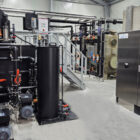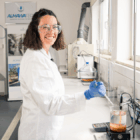Dosing and preparation station refers to an important component in industrial water and wastewater treatment that is responsible for the precise and continuous dosing of chemicals in a water or wastewater stream. These stations are designed to accurately dose chemicals either in concentrated form or after dilution and dissolution to achieve specific treatment objectives such as pH regulation, precipitation of heavy metals, flocculation of solids and prevention of scaling.
Table of contents
Technical basics of the dosing and preparation station
A dosing and preparation station usually consists of several main components:
- Dosing pumps: These pumps are responsible for the controlled supply of chemicals. They work with high precision and at regular intervals to ensure constant dosing.
- Preparation water tank: This is where the chemical concentrate is mixed with water so that a specified dilution is achieved before the solution is fed into the main stream. The size and material of the tank depend on the area of application and the properties of the chemical to be dosed.
- Agitators: Agitators are necessary to ensure that the chemicals dissolve evenly in the water and a homogeneous solution is created.
- Monitoring systems and sensors: These systems continuously measure parameters such as the level of chemicals, the pH value, conductivity and the concentration of dissolved substances. In this way, dosing can be automated and adapted to the current contamination of the water.
Functionality and use of the dosing and preparation station
The dosing and preparation station works on a simple but effective principle: a chemical solution is prepared in a storage tank and fed from there into the waste water or water system by a dosing pump. Depending on requirements, the station can work continuously or intermittently and regulate the dosing quantities so that the chemical target values are achieved.
One example of the use of a dosing and preparation station is the addition of flocculants to promote the formation of stable flocs, which can then be removed in the subsequent process by sedimentation in CP systems or flotation. In many applications, the dosing and preparation station is combined with a load control system so that the quantity of chemicals is automatically adjusted to the current water load.
Typical areas of use and applications
Dosing and preparation stations can be found in numerous areas of water and waste water treatment, especially in:
- Precipitation and flocculation processes: Precise dosing of precipitants and flocculants is required for the removal of heavy metals or the sedimentation of solids. This includes, for example, the addition of iron or aluminum salts for heavy metal removal.
- pH control: Dosing stations are often used in the neutralization of acidic or alkaline wastewater, where precise quantities of caustic soda, sulphuric acid or milk of lime must be added to regulate the pH value.
- Corrosion protection and biocide treatment: During cooling water treatment, corrosion protection agents and biocides are dosed to prevent deposits and microbiological growth in the systems.
- Membrane processIn reverse osmosis, dispersants or antiscalants are dosed to prevent the formation of deposits and fouling and thus increase the efficiency and service life of the membranes.
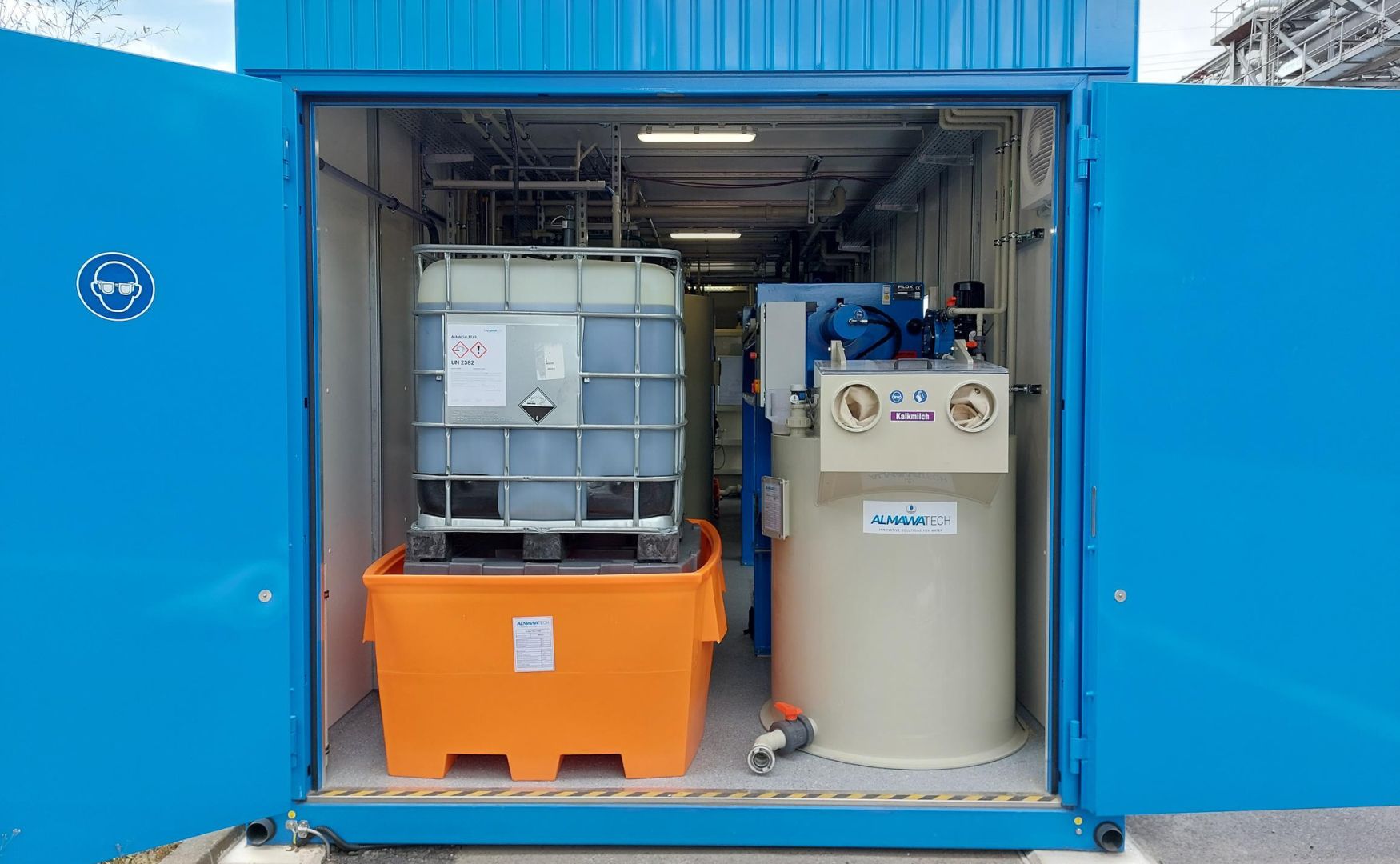
Photo: IBC dosing station for precipitant (left) and dosing and preparation station for the neutralizing agent milk of lime (right) installed in the ALMA Modul technical room container
ALMAWATECH dosing technology: Customized solutions for industrial water and wastewater treatment
ALMAWATECH offers a range of specialized dosing technology solutions that are optimally tailored to the needs of our customers and the requirements of industrial water and wastewater treatment. Our products are specially developed for precise, reliable and economical dosing:
1. ALMA FLOC AC - Automatic dosing and preparation station for flocculants:
- This station enables the precise and controlled addition of flocculants to optimize the aggregation and sedimentation of solids in wastewater. The automatic preparation process ensures that the flocculants are always available in the correct concentration, which guarantees consistent and reliable flocculation.
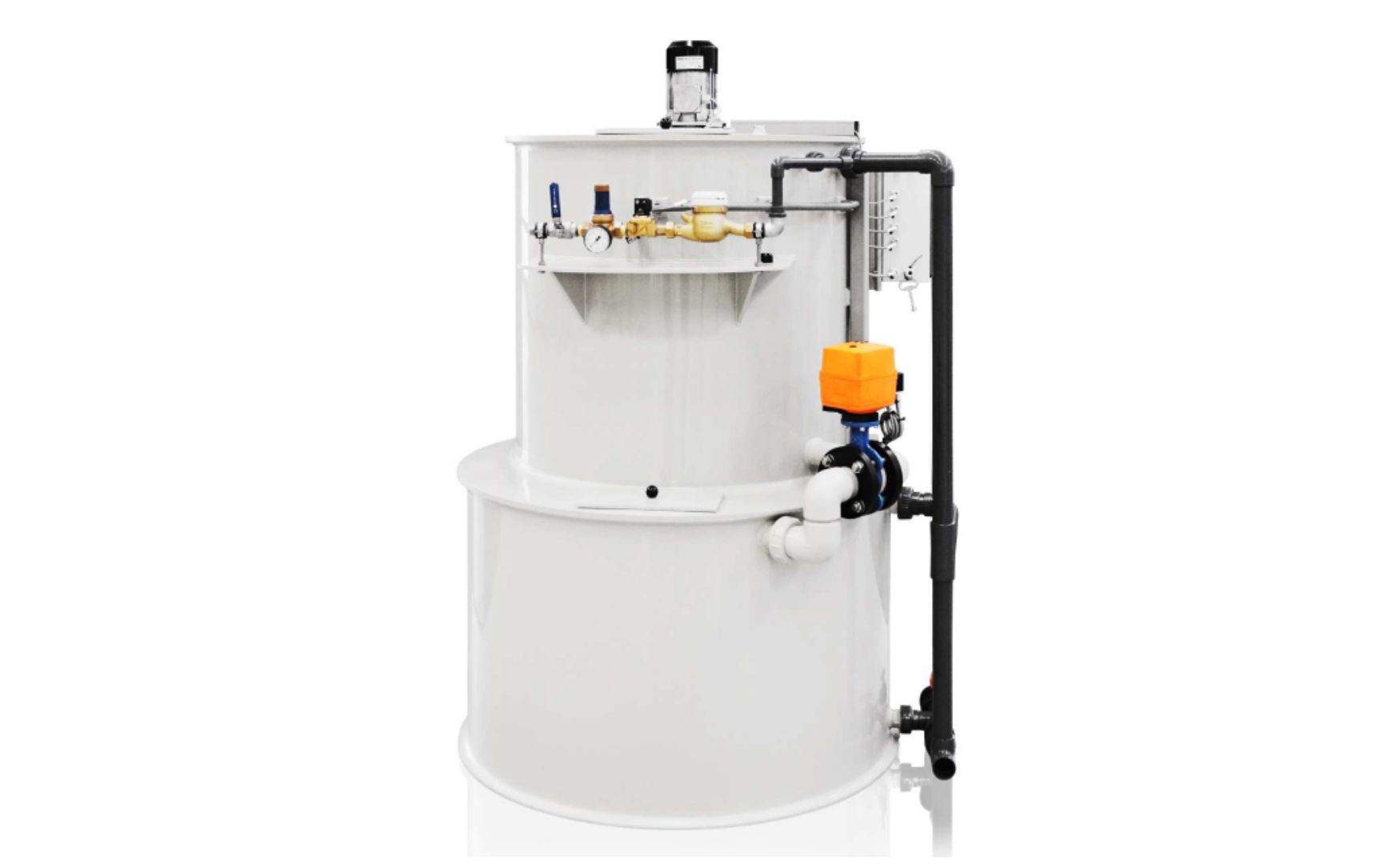
2. ALMA LIME - preparation and dosing station for milk of lime:
- For applications that require pH adjustment using milk of lime, the ALMA LIME offers an automated preparation and dosing solution. This station is robustly designed to prepare and dose milk of lime with high precision and is equipped with special seals that can withstand abrasive media.
3. ALMA dosing station for various delivery containers:
- Our delivery container-compatible dosing station enables easy integration and safe connection of IBC containers, 30/60 liter containers or 200 liter chemical drums to the dosing system. This is particularly advantageous in large systems with high chemical consumption, as dosing takes place directly from the large containers.
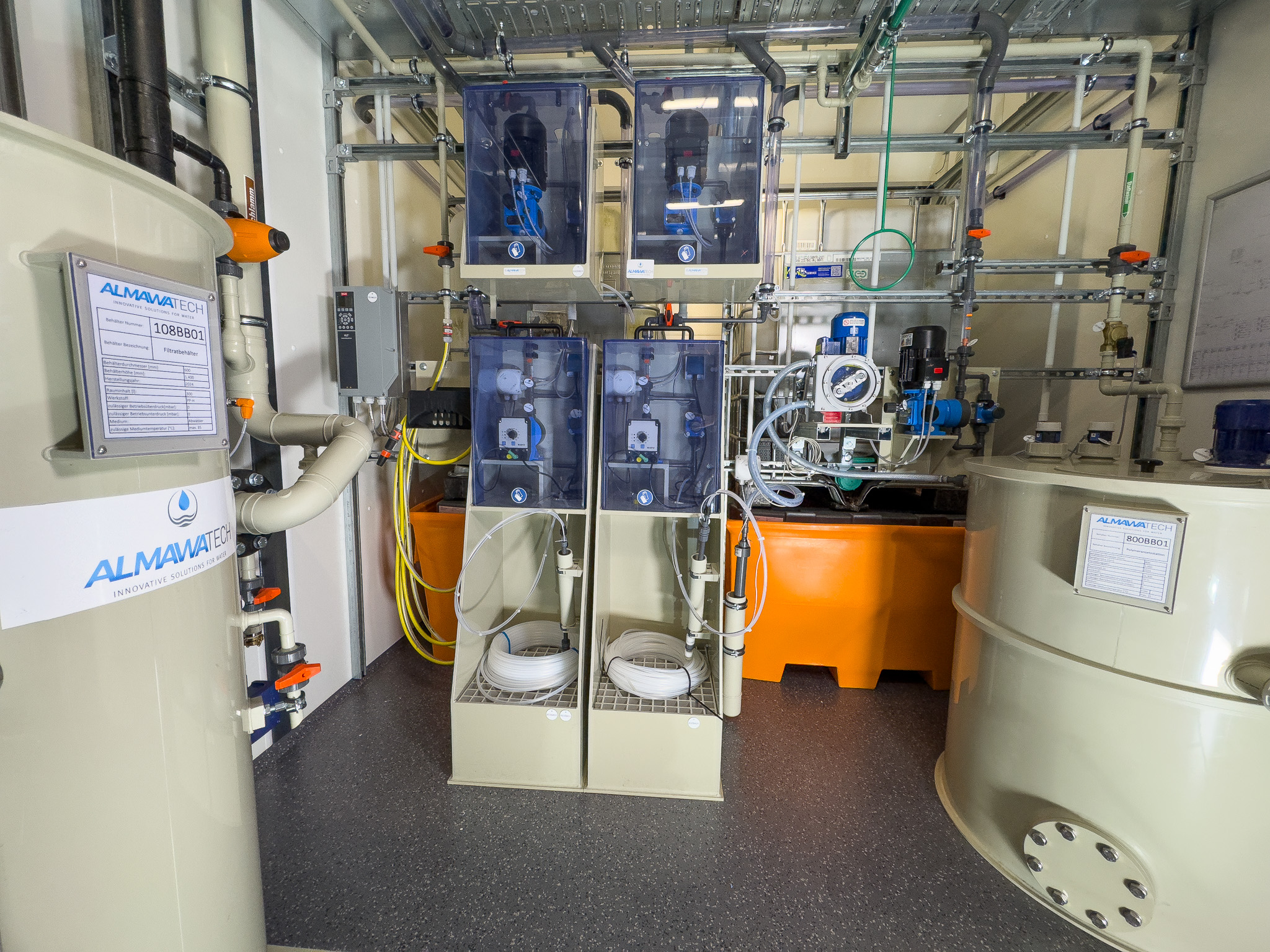
Photo: Double dosing station for 30 liter containers (foreground) and double IBC dosing station (background), dosing and preparation station for flocculants (right)
All our dosing stations are equipped with an automatic empty signal, overfill sensor and durable sealing materials (NBR, FKM, EPDM, etc.) to ensure a high level of operational safety and durability. These safety precautions ensure continuous monitoring of the operating status and enable uninterrupted operation, even with intensive use and large throughput volumes.
Control and load-proportional dosing: ALMAWATECH's advanced dosing technology
One of the key requirements in industrial dosing technology is the ability to adapt the dosing to the actual load of the water. ALMAWATECH offers a special control and online measurement system that enables load-proportional dosing. This intelligent control technology continuously monitors the water quality and adjusts the dosing quantity in real time to fluctuations in the water composition.
- Automatic adjustment of the dosing quantity: Based on the online measured values such as COD, TOC, pH, conductivity or turbidity value, the dosing is automatically regulated to ensure an optimum dosing quantity and avoid overdosing.
- Reduction of chemical consumption: The load-proportional dosing minimizes chemical consumption, which reduces operating costs and maximizes the efficiency of water treatment at the same time.
- Efficient control of dosing stations: The integrated control technology enables centralized control and monitoring of dosing stations, allowing for quick adaptation to changing water conditions.
Advantages and challenges of dosing and preparation technology
Advantages:
- Precise dosing: Dosing and preparation stations allow an exact supply of chemicals, which leads to effective treatment and optimizes consumption.
- Reduced operating costs: Precise dosing and adjustment to the water load minimizes the use of chemicals, which reduces costs.
- Flexibility and adaptability: The dosing stations can be adapted to different chemicals and applications, making them versatile and usable for different industries.
Challenges:
- Complexity of the systems: The integration of dosing and batching stations can be complex and requires precise planning and regular maintenance.
- Material resistance: Depending on the chemical, special materials are required to ensure a long service life of the components, as aggressive media can put a lot of strain on the stations.
- Dependence on measuring devices: The accuracy and efficiency of the dosing station depends heavily on the online measuring devices. Regular calibration and maintenance are necessary to ensure consistent performance.
Conclusion
Dosing and preparation stations are an indispensable part of industrial water and wastewater treatment, as they enable the precise and controlled addition of chemicals and thus increase the efficiency and quality of treatment. ALMAWATECH offers customized solutions such as the ALMA FLOC AC, ALMA LIME and the delivery container-compatible dosing station, which are characterized by precision, robustness and user-friendly operation. With advanced control technology and load-proportional dosing, our systems help to reduce operating costs while ensuring stable water and wastewater treatment that meets the highest requirements.
For further information on our products, please feel free to contact us at any time!
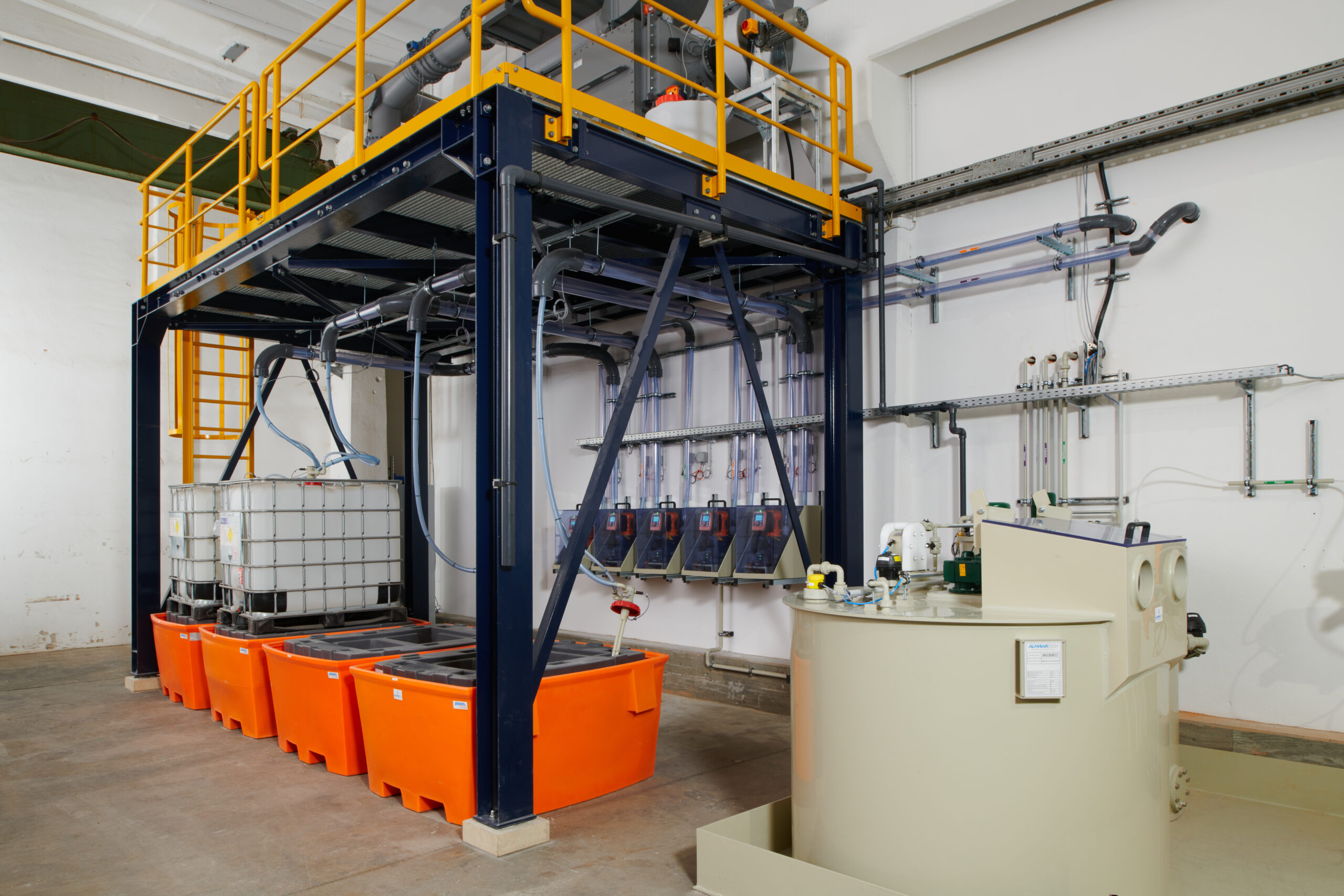
Photo: IBC dosing station with WHG collection tray (left) and ALMA LIME milk of lime dosing and preparation station (right)





